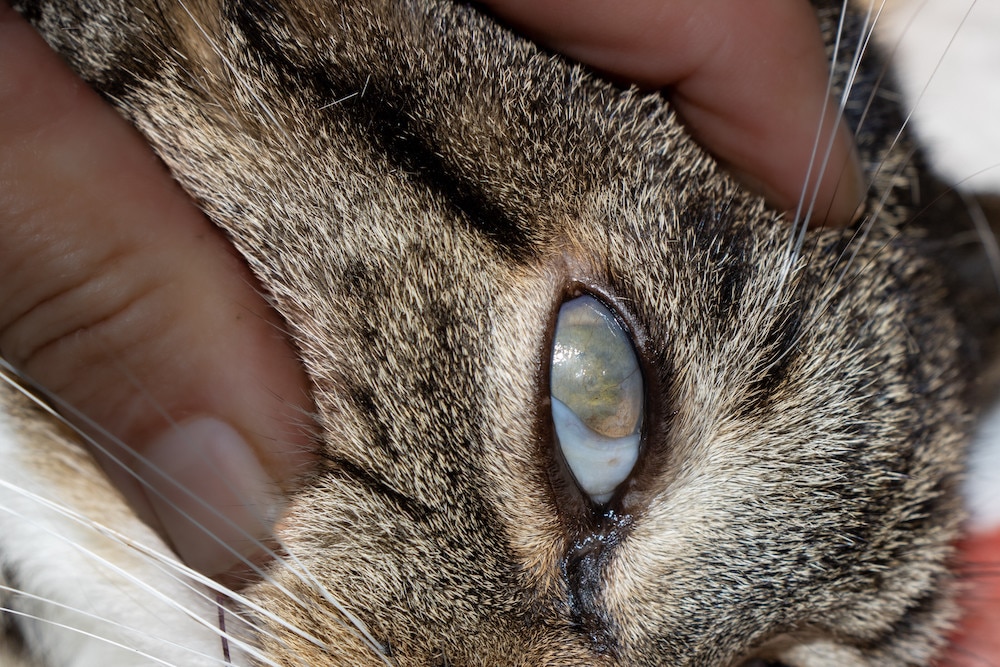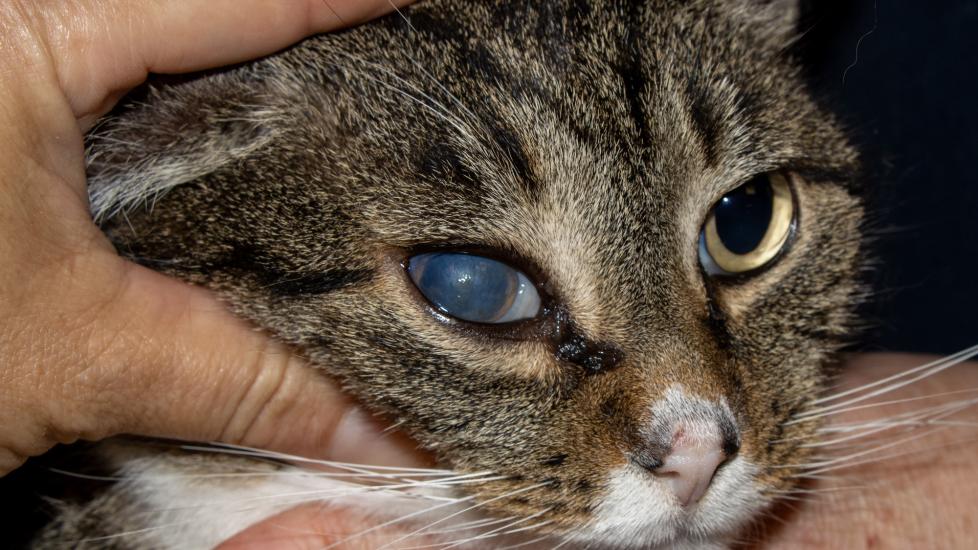Cloudy Eyes in Cats
Eye problems are some of the most common health issues that cats face. A cloudy eye is often one of the first clinical signs noted by pet parents.
Conditions that cause cloudiness in the eye can range from mild to severe. Cats of all ages can be at risk for cloudiness in the eye, although the reasons tend to differ among life stages.
What To Do if Your Cat’s Eyes Are Cloudy
It can be difficult to determine when eye cloudiness is a medical emergency. If the cloudiness is gradual and is noted in both eyes, then you can likely wait to see your veterinarian for evaluation.
If the cloudiness is sudden or paired with pain, squinting, excessive tearing, swelling, bulging, redness, yellow/green or bloody discharge, lethargy, vomiting, diarrhea, weakness, swollen joints/lameness, fever, or lack of appetite, then bring your cat to your veterinarian or emergency vet as soon as possible.
Many cat eye issues can worsen without appropriate treatment, even leading to blindness or rupture of the eye. So it’s important to have your cat evaluated as soon as possible if you are concerned, if it’s sudden, or if or your cat seems to be in pain.
What to Check for With Cloudy Eyes in Cats
It’s important to make notes about the cloudiness and to know what other symptoms to look for.
Here are some important questions to answer and assess at home if you are concerned that your cat has a cloudy eye:
-
Is the cloudiness in just one area of the eye, or does it cover the entire cornea (the outer layer of the eyeball)?
-
Is the cloudiness in front of the pupil (the black part) or behind it?
-
Is the cloudiness in one or both eyes?
-
Does your cat seem to be able to see? Are they bumping into things around your home? Are they hesitant to go into dark rooms or to jump onto or off of things?
-
Is there any squinting or rapid blinking in one or both eyes?
-
Is there excessive tearing or abnormal discharge (green, yellow, or bloody) in one or both eyes?
-
Is there bulging in one or both eyes?
-
Does your cat have other symptoms such as sneezing, congestion, lethargy, decreased appetite, vomiting, diarrhea, or weight loss?
These are all important questions that can sometimes be answered before you even get to a veterinary hospital. The answers can help narrow the investigation into the underlying cause of the eye cloudiness.
Causes of Cloudy Eyes in Cats
There are many causes of eye cloudiness in cats, including:
Cataracts: With cataracts, the eye lens becomes progressively cloudier, causing blurred vision and possibly blindness if left untreated. The lens is a structure behind the colored iris that focuses light onto the retina, allowing clear vision. Cloudiness interferes with the ability of light to reach the retina, leading to poor vision.
Cataracts can occur in any age or breed of cat, though there is a genetic predisposition in some exotic breeds such as British Shorthairs and Himalayans.
The most common reasons for cataract formation in cats are trauma to the eye, uveitis, or systemic disease (such as diabetes mellitus, viruses, or hypertension).
Nuclear sclerosis (or lenticular sclerosis): In this medical condition, a blue-tinged “haze” forms in the lens of older cats. This is commonly mistaken for cataracts and is a normal change that happens as cats age. Lenticular sclerosis usually does not severely affect vision, though it can affect depth perception and tends to be slowly progressive in both eyes.
Glaucoma: This is an irreversible medical condition where the fluid in the eye is unable to drain appropriately, causing a buildup of fluid within the eye. This causes the pressure in the eye to increase and places pressure on the optic nerve, leading to pain, bulging of the eye, and blindness. Glaucoma must be treated to avoid chronic pain and slow the progression of vision loss.
Glaucoma can affect one or both eyes, and though it often affects cats over the age of 8, it can also be seen in younger cats and even kittens. Clinical signs of glaucoma include red, bulging, painful eyes; excessive blinking; and tearing.
Glaucoma can be primary or secondary. Primary glaucoma is rare in cats and is either inherited or genetic. Burmese and Siamese breeds are predisposed to primary glaucoma. Secondary glaucoma is more commonly seen in cats and is usually caused by severe inflammation within the eye (uveitis). This can be caused by systemic disease such as viruses, diabetes, tumors, bleeding disorders, or luxation of the lens.
Corneal ulceration: This is when the cells of the outer layer of the eye (the cornea) are eroded from trauma, foreign substances such as chemicals, infections, or other rarer conditions. The most common cause of corneal ulceration is trauma to the eye.

Corneal ulcer on a cat's eye. (Photo credit: Sandra Mitchell, DVM)
Ulceration can occur in cats of any breed, age, or sex. The ulcers are often painful and cause squinting, excessive blinking, and increased tear production/eye discharge. They can even be so severe that they lead to swelling, eye rupture, or complete closure of the eye.
Mild cases of corneal ulceration are often treated simply with eye medications and Elizabethan collars to avoid rubbing. More severe cases can sometimes require surgical therapy.
Keratitis: This is a medical condition of the cornea and can be either ulcerative or eosinophilic. Squinting, excessive blinking, increased discharge, swelling, and rubbing are the most common signs. Both types of keratitis are often treated with a long course of eye medication based on the underlying cause, if found.
Ulcerative keratitis is most often seen in exotic breeds such as Himalayans and Persians. It can often lead to corneal ulceration and thus pain, swelling, blinking, increased discharge, rubbing of the eye, and even rupture of the eye itself.
Eosinophilic keratitis is a chronic inflammatory condition of the eye that can affect cats of any breed, sex, or age, although is often seen in cats younger than 4 years old. Often it appears as raised pink, gray, or white lesions on the cornea.
Uveitis: With this condition, the uvea (which contains the iris, ciliary body, and choroid) of the eye become inflamed, causing decreased fluid production and lower pressures within the eye. This condition can be chronic or acute in nature and can affect any age, sex, or breed of cat.
Uveitis can cause excessive blinking, squinting, increased discharge, and cloudiness of the cornea. There are multiple possible causes of uveitis in cats, including infectious diseases (most commonly tickborne or viral), trauma, chronic cataracts, high-fat diets, cancers, and immune-mediated disease.
Sometimes a diagnosis is never found, which can be frustrating for both pet parents and veterinarians. Eye medications, diagnosis, and treatment of the underlying medical condition is necessary to treat the condition itself.
Corneal sequestrum: In this condition, part of the cornea is rejected by the healthy tissue around it. This causes discoloration in this portion of the eye (often pigmented) as well as cloudiness, rubbing at the eye, and increased corneal blood vessels.
It is often seen in exotic breed cats such as Persians, Himalayans, and Burmese breeds. Veterinarians unfortunately do not well understand the cause of this condition. The sequestrum often starts painless, but can eventually become painful. The treatment of choice is surgical removal of the dying corneal tissue, though eye medications have successfully been used to treat mild cases.
How Do Vets Diagnose the Cause of Cloudiness in Cats’ Eyes?
Vets use a variety of tests to assist in diagnosing the cause of cloudy eyes in cats. The first step is to get a thorough history and perform a physical examination to assess for systemic disease. Diagnostic testing includes:
-
Corneal stain: This test places a stain on the outer layer of the eye and helps vets look for abrasions or ulcerations.
-
Intraocular pressure (also called tonometry): This test assesses for glaucoma or uveitis by evaluating the pressure within the eyes.
-
Bacterial culture: The vet takes a small sample of cells from the eye to grow in the lab to help assess for any bacterial invasion.
-
Cytology: This test takes a small sample of cells from the eye to assess under the microscope for specific inflammatory cells.
-
Full bloodwork and urine testing: Often used for systemic assessment of health.
-
Tick disease testing
-
Viral testing
-
Radiographs and abdominal ultrasound are sometimes used when trying to rule out systemic disease as an underlying cause.
Referral to a veterinary ophthalmologist is often considered for cloudiness that is severe, acute, or progressing rapidly, and for cases that are not responding to therapy.
How Do You Treat Cloudy Eyes in Cats?
Unfortunately, there are no over-the-counter treatments for eye cloudiness in cats. Once you notice that your cat is having an eye issue, it is important to make sure that they are not scratching or rubbing their eye. This can cause more pain and inflammation and can even worsen underlying issues. Use an Elizabethan collar if your cat is rubbing an eye until you can bring them in for assessment.
Treatments for cloudy eyes depends on the underlying cause of the cloudiness:
Cataracts: These are not curable with medication. They can be treated with eyedrops and by correcting any underlying health issues. Surgery is usually curative if sight is confirmed prior to surgery.
Nuclear sclerosis (or lenticular sclerosis): Treatment is usually not recommended, although omega fatty acid supplementation (under the direction of a veterinarian) is thought to slow the progression of this condition.
Glaucoma: There is no cure for glaucoma, so treatment is considered palliative. Eyedrops are used to decrease eye pressure and inflammation. Oral pain medication may also be considered. Surgical placement of shunts or complete eye removal are other options for advanced or refractory glaucoma in cats.
Corneal ulceration: Treatment is dependent on the severity. Mild cases often respond well to eye antibiotics and anti-inflammatory medication. More severe cases may require grid keratectomy or surgical conjunctival grafting to repair the defect in the cornea.
Keratitis: Treatment is dependent on the severity and underlying cause. Some cases are treated with anti-inflammatory or steroid eyedrops, while others require anti-viral oral or injectable medications and sometimes systemic therapy.
Uveitis: Treatment is dependent on the severity and underlying causes. Many are treated with steroids, both as eye medication and oral medication, while most successful treatment requires the primary condition to be controlled.
Corneal sequestrum: Mild cases can be treated with antibacterial and anti-inflammatory eye drops while the body dissolves the dying corneal tissue. More severe cases may require surgical removal.
The earlier an eye issue is diagnosed, the easier it is to treat. If your cat’s eye cloudiness shows up suddenly or with other concerning symptoms, bring them to a veterinarian as soon as possible for assessment.
Featured image: Sandra Mitchell, DVM
